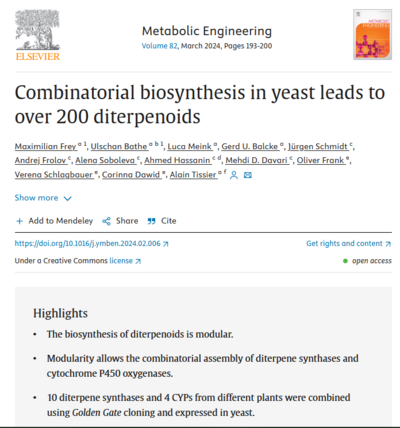Out of the plant - into the yeast! Modern diterpene production through biotechnology.
IPB scientists have recently generated a substantial library of diterpenoids by combinatorial biosynthesis. In a Golden Gate-based approach, they combined the catalytic activities of ten different diterpene synthases with four cytochrome P450 oxygenases from different plant species. The expression of all possible combinations in individual yeast strains led to the production of more than 200 diterpenoids, of which 36 compounds were already known and 13 were fully structurally elucidated.
In general, the biosynthesis of diterpenes starts with the basic precursor molecule geranylgeranyl diphosphate (GGPP), which is converted into the various diterpene scaffolds by the activity of diterpene synthases (diTPS). The end products of diTPS are diterpene olefins or alcohols with linear, macrocyclic or polycyclic structures. These diterpene scaffolds are then modified by cytochrome P450 oxygenases (CYPs), which introduce oxygen groups into the compounds and initiate backbone rearrangements, greatly increasing the structural diversity of the diterpenoids. Many of the CYPs involved in this scenario are promiscuous, accepting not only their natural substrate but also structurally related compounds.
The diTPS used in this study provided (+)-copalyl diphosphate derived scaffolds, while the CYP enzymes used further oxidized and modified these basic scaffolds. For 162 of the 200 compounds produced in yeast, the researchers were unable to find a natural counterpart in the literature and databases. Therefore, these diterpenes are considered to be novel compounds. This diversity of compounds and the high proportion of unknown substances is mainly due to the use of different CYPs from distant plant species. Two CYPs from dicotyledonous plants (rosemary and apple sage), one from rice, which is a monocotyledonous plant, and one CYP from the gymnosperm Sitka spruce were used to oxidize the diterpene backbones.
Since this type of substance generation occurs ab initio and is therefore not dependent on the availability of a specific starting material, the Halle scientists were able to achieve good yields for many diterpene products. Nevertheless, the production efficiency can be increased by further engineering - and this is also planned for further experiments. Overall, the experts conclude that yeast is an ideally suited reaction vessel for the production of diterpenoids. The promiscuity of the enzymes involved turns combinatorial biosynthesis into a promising approach to produce diverse substance libraries. The use of other CYPs, including those from non-plant organisms, or the oxidation of diterpene scaffolds other than the (+)-CPP-derived compounds used here, opens up possibilities for further expanding the product spectrum. The generated diterpenoid libraries can then be screened for biological activities such as antiviral or anticancer properties. The increasingly available transcriptome and genome sequences of plants, fungi and bacteria provide the basis for future combinatorial diterpenoid biosyntheses in the laboratory without the need to breed or cultivate the original organisms.
Terpenoids, the largest class of natural products, include many medically active compounds such as the anticancer drug Taxol® and the antimalarial drug artemisinin. Diterpenoids are C20 compounds consisting of four isoprene units and are found in plants, insects, fungi, and bacteria. In total, it is estimated that more than 18,000 diterpene structures are known, derived from at least 126 different backbone structures. Despite this enormous chemical diversity, the potential of diterpenes has not been fully exploited because they occur often in low concentrations in vivo and the organisms that produce them are often difficult to access or cultivate. Due to their complex structures, the chemical synthesis of diterpenes is also challenging and often fails due to low yields. Identifying the biosynthetic pathways of these compounds is therefore a good alternative to produce them by metabolic engineering in suitable organisms.


